Negotiation is rarely a straightforward process. One of its defining features is unpredictability – the fact that things can happen in an irregular way to the extent that they cannot be predicted by an observer. It’s an inevitable factor that influences every interpretation, exchange, and decision. Not only do circumstances shift unexpectedly, but all parties are simultaneously subject to and agents of this unpredictability, introducing new variables at every turn.
Unpredictable behaviour in negotiations can stem from various sources, such as cultural differences, changing priorities, emotional responses, or deliberate tactics designed to unsettle the other party. This can manifest as sudden shifts in position, ambiguous communication, or unexpected procedural moves. This makes negotiation challenging: you can never be entirely certain what will happen next, or how your counterpart will react. It also raises the stakes, as misreading signals or failing to adapt can quickly derail progress. Therefore, the ability to juggle between sticking to your goal and reassessing your strategy based on to the new information brought by the negotiation, while being pressured by unpredictability, is crucial.
In cross-cultural and cross-organisational settings, particularly within the diverse environment of the EU, unpredictability is almost inevitable due to differing priorities, shifting political stances, and confronting cultural perspectives. Hence, it is essential to understand and manage unpredictable behaviour. What factors might explain the unpredictable behaviour of a counterpart? This first blog explores the five dimensions that can explain why a counterpart could behave unpredictably during negotiations.

Image generated by Napkin.ai by Paul Courtois
1.Spotting Strategic Moves – Recognising Tactics That Shape the Deal
Unpredictability in negotiations could be the result of a deliberate strategy. Some negotiators alternate between cooperation and confrontation, using techniques such as sudden threats, walking away from the table, or changing their demands to destabilise their counterpart and pressure them into making concessions. This ‘chaos strategy’ aims to keep the other party off balance and uncertain, making them more likely to give ground to regain control.
Secrecy and ambiguity are also common tactics. By withholding key information or sending mixed signals, a negotiator can hide their true priorities and intentions. This uncertainty forces the other party to guess their real objectives, often leading them to make concessions just to reduce confusion or move the process forward.
_____________
Illustrative fictitious situation: One civil servant from DG Trade and another one from DG Environment are tasked with negotiating a joint position on new trade regulations. The process begins with a spirit of cooperation, as the Trade official readily accepts several environmental requirements. However, when the proposal fails to gain traction, this same negotiator abruptly threatens to suspend discussions unless an exemption for certain products is introduced. Ambiguity becomes a tactic: it is never clear which issues are truly non-negotiable, and previous statements are sometimes contradicted, all in an effort to unsettle the counterpart. Faced with these shifting signals, the Environment representative grows increasingly uncertain about how to respond. The resulting unpredictability breeds confusion and pressure, eventually leading to thoughts of making concessions simply to bring clarity and move the negotiation forward.
_____________
2.Reading the Room – Decoding Personality and Emotional Signals
Psychological pressure affects negotiators in various ways. High-stress situations, ongoing ambiguity, and rapidly changing circumstances can overwhelm negotiators, leading to cognitive overload and inconsistent, reactive behaviour.
Emotional instability such as anxiety, frustration, or overconfidence, may cause impulsive actions and sudden shifts in stance or tone.
Unconscious biases and mental shortcuts such as loss aversion, attribution bias, or heightened threat perception, can trigger unexpected demands or concessions, further adding to the unpredictability.
_____________
Illustrative fictitious situation: In the Member State A’s Ministry of Defence, two units – one responsible for operational planning, and the other for logistics management – are collaborating to implement a new protocol for supporting forces during external deployments. There is a great deal of pressure due to very tight implementation deadlines and uncertain strategic directions. Facing an increasing number of last-minute adjustments to the specifications, a member of the operational team who had previously supported pooling resources suddenly changes their mind. This U-turn triggers a knee-jerk reaction from the logistics team: its manager immediately demands stricter control criteria for the flow of materials, but then backs down shortly afterwards.
During the discussions, the fear of losing certain advantages leads the logistics team to accept a concession on monitoring procedures without question as soon as the issue of costs is raised. The operational team, influenced by attribution bias, misinterprets a technical question about equipment availability as a challenge to their competence, further straining the negotiation atmosphere.
_____________
3.Bridges or Barriers? Trust and Communication Dynamics in Action
The quality of the relationship between the negotiating parties has a strong influence on behaviour at the negotiating table. When trust is lacking or there is a history of broken promises, negotiators could often become defensive and more erratic, suddenly changing their positions, reneging on agreements, or making unpredictable demands. This makes it difficult for the other side to rely on commitments, as confidence quickly gives way to caution and suspicion.
Communication barriers add to this unpredictability. Misunderstandings, language differences, or contrasting styles can lead to confusion and give the impression that intentions are inconsistent. When parties struggle to communicate efficiently, building rapport and mutual understanding becomes difficult, which increases the risk of negotiations stalling or agreements being fragile.
_____________
Illustrative fictitious situation: During a multilateral negotiation session overseen by the United Nations, several national delegations come together to draw up an agreement on the sharing of strategic data. From the outset, trust between certain parties is fragile, as previous commitments have not always been honoured. During the discussions, one delegation suddenly changes its position on access to the data, introducing new conditions that make the other participants doubt the sincerity of future commitments.
Communication is further complicated by the fact that, although English is the working language, the representatives have different mother tongues and styles of expression. Misunderstandings arise when one delegation misinterprets the new conditions set out by another, perceiving an inconsistency in the stated intentions. Despite several attempts at clarification, neither party is willing to commit fully, fearing further U-turns or misinterpretation of the agreements. This climate of uncertainty and mistrust is hampering progress in the negotiations and emphasises the importance of language skills, clear communication, and trust in the success of multilateral processes.
_____________
4.Behind Closed Doors – Decoding Internal Organisational Forces
The internal dynamics of a counterpart’s organisation should not be forgotten when talking about unpredictability factors. Disagreements, conflicting interests, or a lack of clarity among team members may result in unexpected changes of position or message. Rapidly changing priorities or unresolved internal debates may result in inconsistent stances, making it difficult for the other party to anticipate moves or trust commitments.
Bureaucratic constraints, such as slow decision-making processes, frequent leadership changes, or unclear lines of authority, can cause sudden reversals, delays, or last-minute changes. Even well-intentioned negotiators may appear unreliable if they don’t have the authority or clear guidance needed to act consistently or make firm commitments.
_____________
Illustrative fictitious situation: A digital service’s project manager and a protocol service’s head of unit from the Council of the EU have been tasked with developing a secure digital invitation system for upcoming high-level summits. Their initial meetings are productive, with both parties clearly outlining their respective technical requirements and protocol standards. However, the digital project manager frequently receives conflicting feedback from different service heads of unit, leading to abrupt changes in approach, even during ongoing discussions. At one point, the project manager withdraws from a technical solution that had previously been agreed, citing new cybersecurity priorities imposed by senior management. Each phase of the project requires validation by their respective hierarchies, and the recent restructuring of the digital team adds further unpredictability and delays.
Consequently, the protocol service’s head of unit is finding it increasingly difficult to anticipate the digital manager’s decisions or rely on previous commitments. Despite mutual goodwill, the shifting instructions and lack of clear, unified decision-making hinder progress and put a strain on the collaboration, testing the patience of both parties.
_____________
5.The Big Picture – Reading Cultural and Contextual Signals
Cultural norms have a strong influence on counterpart’s behaviours during negotiation, as well as on how they are perceived by another. Each culture has its own expectations regarding negotiation styles, such as whether to be direct or indirect, formal or informal, or collaborative or competitive. These expectations can affect both how negotiators act and how their actions are perceived by others. These differences in communication style can easily lead to misunderstandings, making it harder to interpret intentions or anticipate actions.
Situational uncertainty also fuels unpredictability, as it directly affects both the process and the outcome of negotiations. Uncertainty relating to unexpected new information appearing during negotiations could force negotiators to make sudden changes to their strategy and objectives.
_____________
Illustrative fictitious situation: A public health official from Member State A’s Ministry of Health and a crisis management coordinator from Member State B’s Ministry of Civil Protection are drafting a joint response plan for cross-border health emergencies. The public health official, coming from a culture that values direct communication, opens with clear demands and deadlines. In contrast, the crisis management coordinator, coming from a culture that favours indirect communication, responds with nuanced suggestions and avoids giving an explicit refusal. The public health official interprets negatively this as evasiveness, while the crisis management coordinator views the blunt approach as confrontational.
Amid their negotiations, an unexpected outbreak in a neighbouring region introduces urgent new variables. The public health official abruptly shifts funding priorities without providing any context, making them appear inconsistent to the other party. Meanwhile, the crisis management coordinator’s reserved reaction to the news seems like concealment to the direct negotiator.
_____________
Conclusion
Unpredictability in a negotiation’s counterpart can stem from a variety of factors, including strategic, psychological, relational, organisational, and contextual elements. Analysing these elements helps to better manage uncertainty, protect your interests, and work towards constructive outcomes, even when the path ahead is unclear.
Recognising the sources of unpredictability enables you to prepare more effectively. However, understanding the roots of unpredictability is only the first step. How do you react it? The next blog will explore effective strategies for dealing with an unpredictable counterpart during a meeting. This will include how to maintain composure, build common ground, and turn unpredictability into an opportunity for collaborative problem solving.
_____________
Interested in knowing more on how to navigate negotiations with unpredictable counterparts?
Watch the replay of our webinar on ‘Unpredictable Counterparts: Negotiation Tips for Success’, which brought together negotiation experts and experienced practitioners to discuss this theme. The webinar explored practical strategies, psychological insights, cultural intricacies, and real-life lessons learned, providing participants with actionable advice for managing complex interactions in negotiation processes.
Declaration of AI Assistance: generative artificial intelligence tools have been used to review and correct wording and potential spelling errors in this blog post. The final analysis, arguments, critical insights, and conclusions are the result of the author’s work and remain under their sole responsibility.



